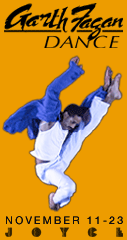
 |

|
 |

|
 |
 |
 |
 |
Go back to Flash Reviews Guerin in the Mix By Chloe Smethurst MELBOURNE -- The Melbourne International Arts Festival, which opened earlier this month, has revealed the recently completed Australian Center for the Moving Image as a fresh new space for dance film screenings as well as live performances. Bringing new audiences to the venue has been "Plasticine Park," choreographed by Lucy Guerin and designed by Patricia Piccinini and others, and which aims to explore the relationship between the body and the silver screen. While perhaps seeming odd at first, the Screen Gallery inside the center was actually a very conducive space for exploring this collaboration between visual artists and dancers. When I viewed the work on October 16, the performances given by the dancers were sharp and clean, while the film work was engaging and purposeful. The premise for the piece is quite interesting -- to make a work where the images on the screen and the live performers 'interact' to create a fully integrated performance. In this, Guerin and Piccinini have ultimately succeeded. Neither element of "Plasticine Park" could exist successfully on its own, but together, the dance and specially commissioned film pieces fit snugly together, bringing depth and complexity to the work. Comprising of a series of eight solos, the performance moves between different worlds, as created by the images on screen and the costumes of the performers. Some are quite realistic and based in the natural world, as in the two solos performed by Kyle Kremerskothen and Kirstie McCracken, "Reservoir of Giving 1" and "Reservoir of Giving 2." David Rosetsky was the visual artist working on these sections, which are set in a designer-style bedroom. Filmed projections of Kremerskothen moving around the room are played on the screen while McCracken performs her solo, and vice-versa, developing a strong relationship between the performing body and the filmed. This complex situation is heightened by recorded voiceovers about a flawed relationship, building a tension between the two realities. The sections which feature Piccinini's work are set in a very different realm, inhabited by strange and at times frightening flesh-colored organisms which are not quite human, but not very far from it. In the first solo, entitled "The Keeper," the relationship between the dancer and the screen is more subtle and implied than in other parts of the work. Here we see Sally Gardner, costumed in a white plastic suit somewhere between that of a beekeeper and an astronaut, involved in a minute sequence of hand gestures. Meanwhile, in the background, Piccinini's creation is birthing an endless supply of floating polyps. This other-worldly feeling is continued in "The Gathering," performed by Stephanie Lake as the final solo of the evening. Beginning at the very back of the long gallery space, Lake is costumed in a similar mode to that of the protuberances on screen. Bulbous, hanging, fleshy bodies with chattering mouths begin to jiggle and squirm as the large screen rolls toward the audience. Here the relationship is again blurred; is the dancer part of their world or ours? Different again is the visual art work by Stephen Honegger, which, when projected onto the big screen creates a digital world for the dancers to inhabit and interact with. In fact, it is one of the pieces which Honegger collaborated on, "Create Grid," danced with great precision by Brett Daffy, which is possibly one of the most successful in "Plasticine Park." The way the 3D grid on screen moves with the performer is mesmerizing, while the choreography takes on mechanical, almost digital elements, forging a strong link between the two. Unfortunately, this section is placed at the far end of the gallery, distancing the work too much from the audience. This meant that some of the detail was lost, leaving the audience disconnected from the performance. While a change in pace was created by the light-heartedness of "Thermogenic Muscle Detonator" and "A New Attitude," where an animated, cartoon-like figure, drawn and animated by Laresa Kosloff, imitates and occasionally appears to dance with Trevor Patrick and Rebecca Hilton respectively, the comic, character-based choreography seemed too flimsy in comparison to the strength of the other sections. The choreography in the solos, all by Guerin, was very strong overall, and obviously suited to each of the individual performers' styles. Piccinini's visual work was fascinating, and although the other artists' contributions were excellent, her pieces were truly outstanding in terms of their artistry and transportive qualities. "Plasticine Park" is a remarkable example of how dance can relate to and enhance other mediums. Each of the elements was crafted in consideration of the other, but without comprising the integrity of either. |
|||||||


